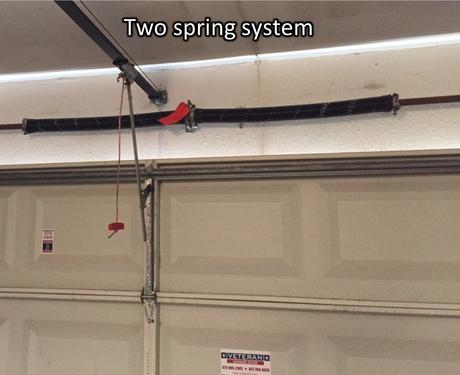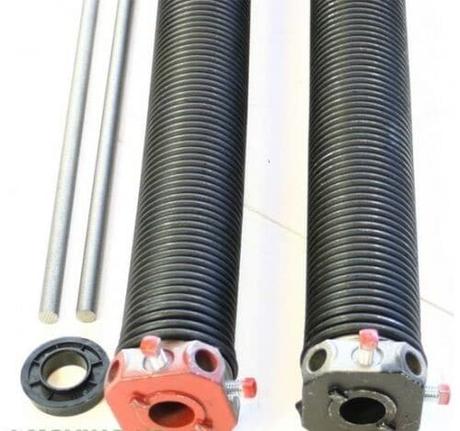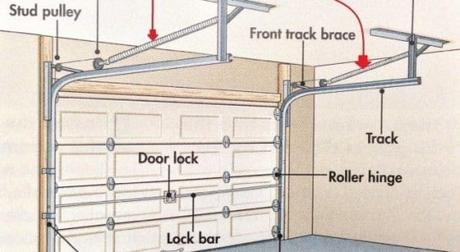How have you been adjusting your Garage Door Springs whenever it need maintenance? This article will guide you through the Step by step procedure To correctly adjust your Garage Door Springs.

Garage door springs act to counteract the weight of the door; this means that it enables the door light enough to allow it to open and close with ease. But when there is a problem with the spring tension, it could cause the garage door to open or close improperly or at the wrong speed.
There are two types of tension springs,

The springs are mounted horizontally above the door opening and run along a stationary metal shaft parallel with the top of the door. The spring uses torque to open/close the door. It is usually used for doors that are larger and heavier.

Mostly used for smaller garage doors. They are mounted on both sides of the door above the horizontal tracks. They fully expand and contract when the door is opened (by hand or motor) to provide a counterbalancing force.
To accomplish this procedure, you'll need some essential tools and safety equipment. The safety equipment includes safety glasses, gloves, and a hard hat while the tools include a sturdy ladder, an adjustable wrench, a C-clamp, a marker or masking tape.
This can be achieved by opening the door until it can't go any farther and hits the stop bolt for a manual door. If it's an automatic door, however, open it using its remote control, then pull its emergency cord down and back until the spring jams in the open position. This will allow you to open the door fully and release the tension in the spring.
Avoid the door falling while you work by placing a C-clamp underneath the bottom rollers. This will fix down the roller while you work.
Use the adjustable wrench to remove the spring hook from the track hanger held in place by a nut. The spring hook is what maintains the tension in the spring.
For a door that's difficult to close or opens too quickly, you'll need to decrease the tension by hooking the spring onto a lower hole on the track hanger.
If the door is difficult to open or closes too quickly, then you need to increase the tension by hooking the spring onto a higher hole on the track hanger.
For a door that doesn't close evenly, decrease the tension by hooking the spring onto a lower hole on the track hanger on the side where the gap is.
To achieve the right tension, adjust the spring by one hole at a time. Put back the nut on the back and tighten the hook into place using the wench once you have moved the hook into its new position.
After adjusting your spring(s) by one hole, unclamp the door and test the springs by lowering the door to see how it works. Make another single-hole adjustment if your door is still not working correctly. Repeat the above steps until you get the correct tension.
Once you are satisfied with the adjustments, make sure you remove anything used to secure the door, pull on the emergency cord to release the spring, reattach the door to the opener and plug in your automatic door opener. Lubricate the springs
In addition to the tools stated for adjusting extension springs, you'll also be needing two winding bars or solid steel rods of about 18 - 24 inches long; determine the diameter of the holes you'll be fixing them into before purchase.
For an automatic door, unplug the opener, then place a c-clamp on the track of the garage door to avoid the door opening while you are adjusting the tension in its spring.
Pinpoint exactly where the spring ends by placing one eye over the stationary center plate. At the point where the spring ends, the winding cone that keeps the spring in place can be found. It has four holes equally spaced around it.
The cone will have two set screws on the center shaft to lock the spring in place. Loosen them by inserting the steel rod or winding cone into the bottom hole on the cone.
Once you have inserted the rod and held the cone in place, loosen the screws with an adjustable wrench. Then, in two successive bars on the cone, insert the bars.
Positioning yourself to the side of the bars is vital so that your head and body are not in the way if the spring breaks.
You'll need to wind the cone up to increase tension for a door that's difficult to open or closes too quickly (in the same direction as the garage door cable goes through the pulley).
For a door that isn't closing correctly, it could be difficult to quickly close or open the door.
( in the opposite direction from how the garage door cable passes through the pulley).
If you don't know how much you need to increase or decrease the tension to get your door balanced, go through the Step, and test your door repeatedly until you achieve the correct tension.
To stretch the spring, keep the bottom-most winding bar in place and remove the other bar. Measure out and mark ¼ inch from the end of the winding cone away from the center.
With the bar still in the bottom hole, pull gently upward on the bar and toward the center plate; as you are doing this, continue holding the bar up and over and hit it gently with the second bar towards the masking tape on the shaft until the spring stretches to meet the mar made on the shaft.
With the adjustable wrench, tighten the set screws that were loosened in step 4 to lock the spring in its new position.
Make sure you replace the screws into their flats if there were any on the shaft.
Some torsion springs mechanisms have springs on both sides of the center plate, then you need to repeat steps four to six on the other side of the center plate to ensure balance.
Unclamp the garage door's track and test the door. If functioning as desired, lubricate the springs and remember to plug back in the opener for the automatic door. If the door isn't working well yet, repeat steps four to 7 until the correct tension is achieved.
Conclusion
As can clearly be seen, it's possible to adjust your garage door springs on your own; it's even easier if its an extension spring. Utmost care should, however, be taken when adjusting torsion springs. Stay on the safe side by putting on all recommended safety equipment, and don't hesitate to call for professional help when needed.

